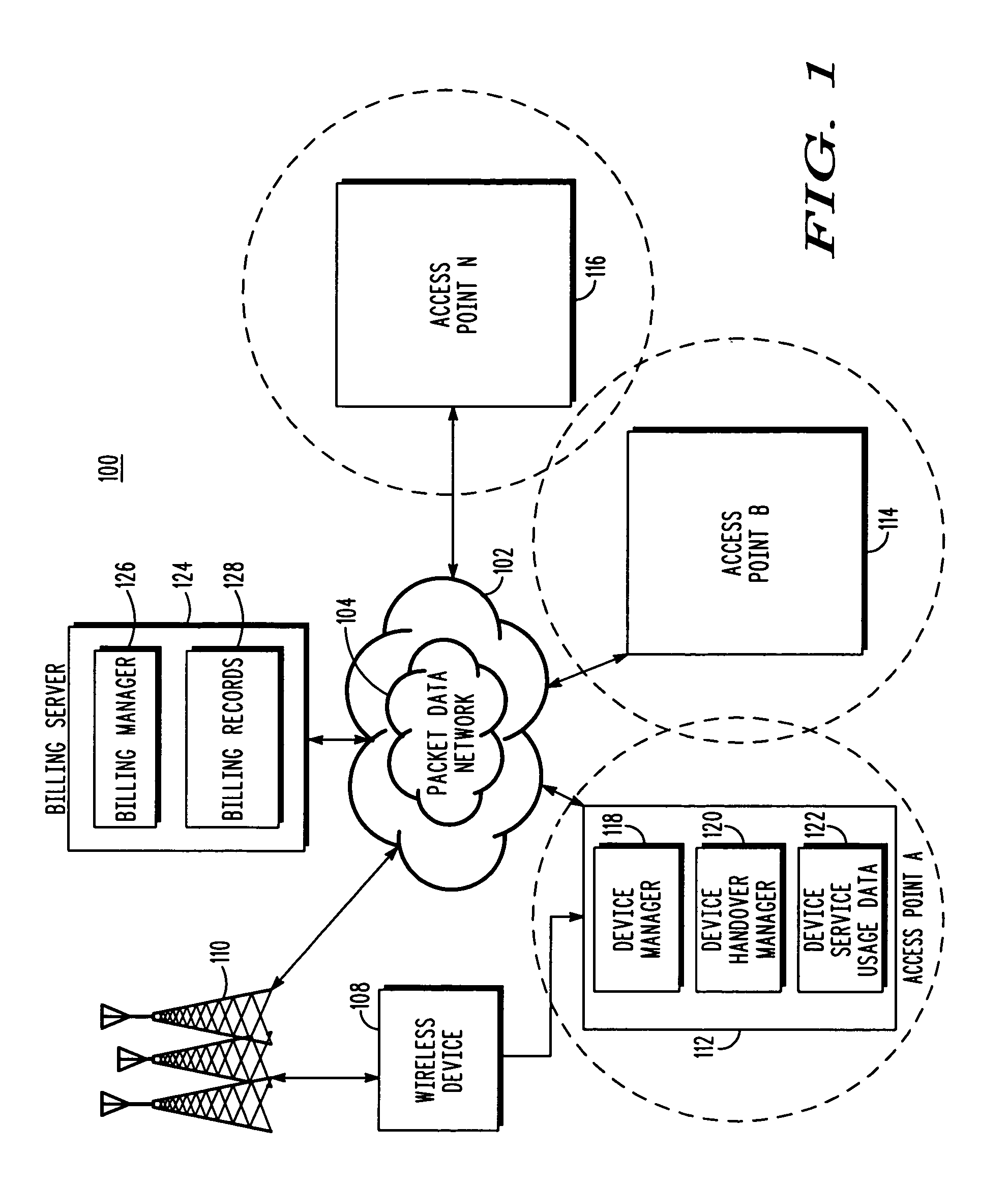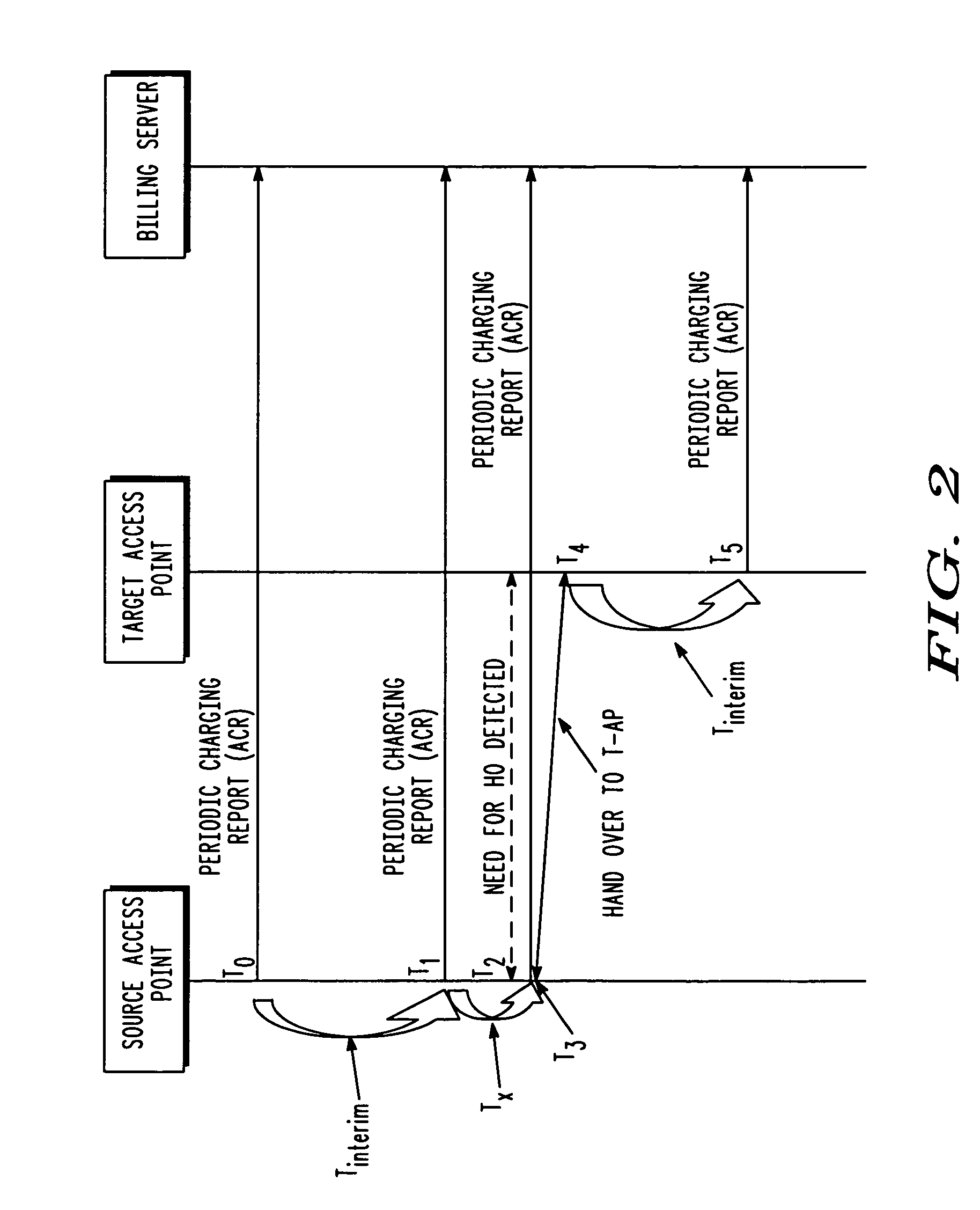Accurate billing for services used across multiple serving nodes
a technology of accurate billing and wireless devices, applied in the field of wireless communication, can solve the problems of creating complexities, creating unnecessary messaging overhead between access points, and creating excessive overhead at the billing system, so as to prevent unnecessary overhead and maintain the integrity of accounting information
- Summary
- Abstract
- Description
- Claims
- Application Information
AI Technical Summary
Benefits of technology
Problems solved by technology
Method used
Image
Examples
first embodiment
[0036]FIG. 2 through FIG. 5 illustrate various methods for managing wireless device service usage and access point migration based on the state of the configurable accounting management parameter in accordance with various embodiments of the present invention. FIG. 2 is a signal flow diagram 200 illustrating a first embodiment for managing device service usage and access point migration. Transactional diagram 200 shows events that occur after a wireless device, such as wireless device 108, registers with a source access point, such as access point 112. As discussed above, when the wireless device 108 registers with the access point 112, the device manager 118 of the access point notifies the billing server 124 so that a charging session can be initiated. For example, the access point 112 sends a DIAMETER ACR_START message to the billing server 124. The billing manager 126 of the billing server determines an interval for receiving accounting records from access points 112, 114, 116. ...
second embodiment
[0042]FIG. 3 shows a signal flow diagram 300 illustrating a second embodiment for managing device service usage and access point migration. Similar to transactional diagram 200, transactional diagram 300 shows events that occur after a wireless device, such as wireless device 108, registers with a source access point, such as access point 112. As discussed above, after a charging session is initiated and the interval for receiving accounting records from access points 112, 114, 116 is determined, the billing manager 126 of billing server 124 sends a configurable accounting parameter to the source access point 112. In the embodiment depicted in FIG. 3, the configurable accounting parameter (e.g., INTERIM_ACR_TYPE) is set to a value of “2” or configuration Type 2 is selected. It should be noted that the value of “2” is only an example for illustrating the different processes that the billing server 124 can instruct the access points 112, 114, 116 to use for managing device service usa...
third embodiment
[0046]FIG. 4 shows a signal flow diagram 400 illustrating a third embodiment for managing device service usage and access point migration. Similar to transactional diagram 200, transactional diagram 400 shows events that occur after a wireless device, such as wireless device 108, registers with a source access point, such as access point 112. As discussed above, after a charging session is initiated and the interval for receiving accounting records from access points 112, 114, 116 is determined, the billing manager sends a configurable accounting parameter to the source access point 112. In the embodiment depicted in FIG. 4, the configurable accounting parameter (e.g., INTERIM_ACR_TYPE) is set to a value of “3” or configuration Type 3 is selected. It should be noted that the value of “3” is only an example for illustrating the different processes that the billing server 124 can instruct the access points 112, 114, 116 to use for managing device service usage and access point migrati...
PUM
 Login to View More
Login to View More Abstract
Description
Claims
Application Information
 Login to View More
Login to View More - R&D
- Intellectual Property
- Life Sciences
- Materials
- Tech Scout
- Unparalleled Data Quality
- Higher Quality Content
- 60% Fewer Hallucinations
Browse by: Latest US Patents, China's latest patents, Technical Efficacy Thesaurus, Application Domain, Technology Topic, Popular Technical Reports.
© 2025 PatSnap. All rights reserved.Legal|Privacy policy|Modern Slavery Act Transparency Statement|Sitemap|About US| Contact US: help@patsnap.com



